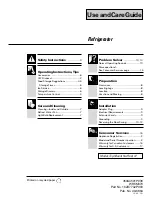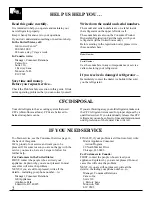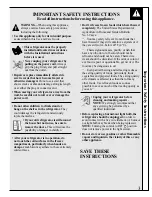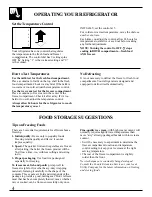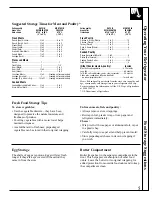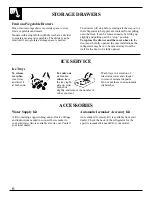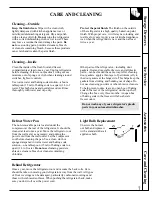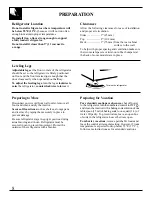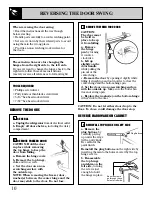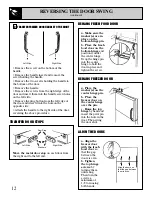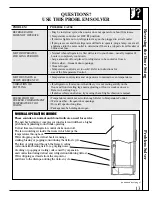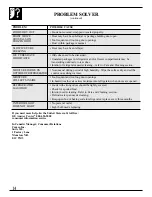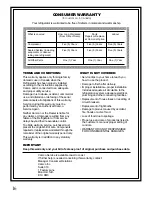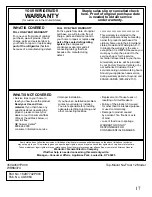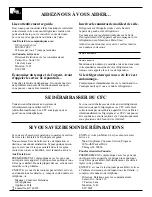
5
Suggested Storage Times for Meat and Poultry*
Eating quality
DAYS IN
MONTHS IN
drops after
REFRIGERATOR
FREEZER
time shown
AT 35° to 40°F.
AT 0°F.
(2° to 4°C.)
(-18°C.)
Eating quality
DAYS IN
MONTHS IN
drops after
REFRIGERATOR
FREEZER
time shown
AT 35° to 40°F.
AT 0°F.
(2° to 4°C.)
(-18°C.)
Fresh Meats
Roasts (Beef & Lamb) ...................... 3 to 5 ...........................6 to 12
Roasts (Pork & Veal) ........................ 3 to 5 ...........................4 to 8
Steaks (Beef) .................................... 3 to 5 ...........................6 to 12
Chops (Lamb)................................... 3 to 5 ...........................6 to 9
Chops (Pork) .................................... 3 to 5 ...........................3 to 4
Ground & Stew Meats ...................... 1 to 2 ...........................3 to 4
Variety Meats .................................... 1 to 2 ...........................3 to 4
Sausage (Pork) ................................. 1 to 2 ...........................1 to 2
Processed Meats
Bacon ................................................... 7...................................1
Frankfurters.......................................... 7 .................................1/2
Ham (Whole)........................................ 7 ...............................1 to 2
Ham (Half) ........................................ 3 to 5 ...........................1 to 2
Ham (Slices)......................................... 3 ...............................1 to 2
Luncheon Meats ............................... 3 to 5 ..........Freezing not recommended.
Sausage (Smoked) ............................... 7..............Freezing not recommended.
Sausage (Dry & Semi-Dry) .............14 to 21 ........Freezing not recommended.
Cooked Meats
Cooked Meats and Meat Dishes........ 3 to 4 ...........................2 to 3
Gravy & Meat Broth .......................... 1 to 2 ...........................2 to 3
Fresh Poultry
Chicken & Turkey (Whole) ................ 1 to 2 ..............................12
Chicken (Pieces) ............................... 1 to 2 ...............................9
Turkey (Pieces) ................................. 1 to 2 ...............................6
Duck & Goose (Whole)..................... 1 to 2 ...............................6
Giblets............................................... 1 to 2 ...............................3
Cooked Poultry
Pieces (Covered with Broth) ..............1 to 2................................6
Pieces (Not Covered) ........................ 3 to 4 ...............................1
Cooked Poultry Dishes ..................... 3 to 4 ...........................4 to 6
Fried Chicken .................................... 3 to 4 ...............................4
(Other than for meats & poultry)
FREEZER
Most fruits and vegetables ................................................8-12 months
Lean fish.............................................................................6-8 months
Fatty fish, rolls and breads, soups, stew, casseroles .........2-3 months
Cakes, pies, sandwiches, leftovers (cooked),
ice cream (original carton) ............................................1 month max.
Meats, fish and poultry purchased from the store vary in quality and
age; consequently, safe storage time in your refrigerator will vary.
For meat and poultry information, call the U.S. Dept. of Agriculture
at 800-535-4555.
*U.S. Department of Agriculture
Egg Storage
Butter Compartment
The shells of eggs are porous. Eggs will stay fresh
longer if they are kept covered in the carton they
came in from the store.
Butter keeps best in the separate compartment in the
door. This helps prevent absorption of other food
odors. Leave the butter in its original wrapping for
added protection from outside food odors and to keep
the compartment clean.
Fresh Food Storage Tips
To store vegetables:
• Use the vegetable drawers—they have been
designed to preserve the natural moisture and
freshness of produce.
• Covering vegetables with a moist towel helps
maintain crispness.
• As a further aid to freshness, prepackaged
vegetables can be stored in their original wrapping.
Unfrozen meats, fish, and poultry:
• Always remove store wrappings.
• Rewrap in foil, plastic wrap or wax paper and
refrigerate immediately.
Cheese:
• Wrap well with wax paper or aluminum foil, or put
in a plastic bag.
• Carefully wrap to expel air and help prevent mold.
• Store prepackaged cheese in its own wrapping if
you wish.
Operating Y
our Refrigerator
Food Storage Suggestions
Summary of Contents for UseandCareGuide
Page 18: ...18 NOTES ...
Page 36: ...18 NOTES ...

